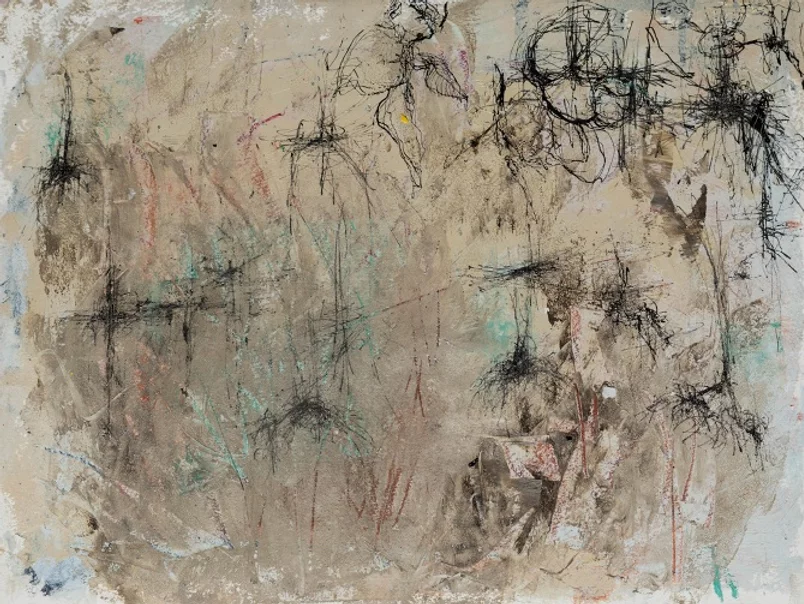Pg Art Gallery presents ‘Pictures of Nothing’, a group exhibition showcasing a historical, methodological and thematic survey of contemporary abstraction, bringing together a multi-generational conversation between artists from different peripheries, forming an expanded picture of the global. ‘Pictures of Nothing’ takes its name from the late Kirk Varnedoe’s eponymous 2006 book, examining the legacy of the abstract form after Pollock. While Varnedoe’s book is explicitly Western-centric, we share with him an opposition to formalism as a pure form; instead we read the abstract in art as an ‘evolving sign system’ that acquires meaning from its social context. This sign system is a multi-sourced, pluralistic and dynamic mechanism able to incorporate a multitude of beginnings.
‘Pictures of Nothing’ is primarily an attempt to live in a world without pictures, or, where representation is depleted and how we respond to this condition. We learn from Varnedoe’s book that abstraction is also a search for a temporary degree of meaninglessness; in order to reveal the essential. In the first section of the exhibition, ‘Life without Pictures’, centered on a post-minimalist process-sculpture (2002-2017) by Devran Mursaloğlu we engage with ideas of deep time. These are in turn complemented by works of younger artists related to the nature of space: A fragment from the abolished constellations by Alexandra Paperno and the post-utopian architectures of Amba Sayal-Bennett, as well as Hala Schoukair’s polyhedrons and Sergey Rozhin’s concept of wood.
The second section ‘Sign-Place Systems’, makes reference to processes of translation and transmission between language and the ‘event’, first in a tripartite dialogue with cities, between the artists Eda Soylu, Sandra Çavdar and Katherina Olschbaur, on the memory of transformation and turmoil in Istanbul and Athens. The third section, ‘Historical Dialogues’, begins with the humorous response of Siberian cultural icon Damir Muratov to the legacy of Malevich, but is centered on a bi-generational conversation: The late Bilge Friedlaender, only recently re-discovered in Istanbul, questions the minimalist tradition in a number of works from 1970s, while remaining simultaneously in dialogue with her pupil and friend Kevin Finklea, a post-minimalist painter, who presents in the exhibition a tribute to Raoul de Keyser. Chris Barnard, on the other hand, is set to investigate the colonial representation of the American West in modern painting.
In the fourth section, ‘Formalisms’, dormant debates on the nature of abstraction latently awake, with a slight reference to the much discussed zombie formalism, but with a very different genealogical tree: Young Russian artists Ivan Novikov, Petr Kirusha and Vitaly Barabanov discuss current abstract formalism from different contemporary sources. While the sections overlap, and different readings are possible, it is our belief that ‘Pictures of Nothing’, set in Istanbul against a background of constant transition, demands from the viewer to relate to its abstract signs not as an evasion of the real but as a multidirectional system of thought, able to tackle the social, political and cultural, in an era of profound disembodiment, emotional impoverishment and endless mobility.
These phenomena, a reality in the world, are matched by the economic and industrial complex tasked with making reality opaque, and therefore invisible to the naked eye. It is here that art begins to seek an uncanny return to the real. This return, however, does not take the form of realisms, but rather of tracing signs of the real as a space of potential transcendence happening in the here and now. Why abstract art now? That was the question with which Varnedoe ends his seminal text, and it remains unanswered for us, faced with the prospect of the contemporary becoming an outdated historical form. With our picture-centric visual culture in full-blown decline, the question of the thinkers of the anthropocene becomes more poignant: How to live here with real objects?
‘Pictures of Nothing’ will run at PG Art Gallery September 9 through October 7. The exhibition is curated by Arie Amaya-Akkermans and a catalog will be issued edited by the curator. A public program for the exhibition will be announced shortly. Acknowledgements: Gallery 11/12 (Moscow), Agial Art Gallery (Beirut), Alexandra Paperno (Moscow), the Estate of Bilge Friedlaender (New York), Carbon 12 Gallery (Dubai), Alos Cavdar (Istanbul), Fred Giampietro Gallery (New Haven, CT), Iragui Gallery (Moscow), Katherina Olschbaur (Vienna), Kevin Finklea (Philadelphia), Osnova Gallery (Moscow), Pop/Off Gallery (Moscow), Sergey Rozhin (Moscow), Alfred Tarazi (Beirut).

